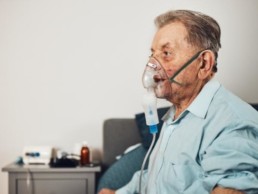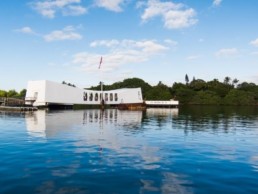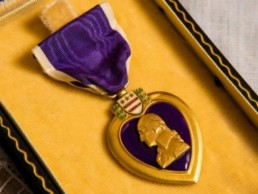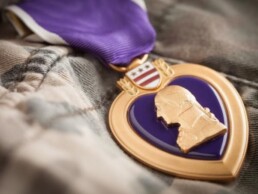Recognizing Our Veterans This Mesothelioma Awareness Day
This September 26th marked the 17-year anniversary of Mesothelioma Awareness Day. This is a day devoted to spreading awareness about this rare and extremely aggressive form of cancer. What many do not know is that mesothelioma is one of the few non-genetic forms of cancer and is usually spoken in tandem with asbestos. Asbestos is the only known culprit of mesothelioma and was heavily used throughout the military from the early 1900s up until the 1980s. Unfortunately, its past use in the military has led to emerging mesothelioma cases today, with roughly 900 new mesothelioma diagnoses annually among our veteran population.
Exposure In The Air Force
For veterans of the Air Force, exposure to asbestos most likely happened on actual Air Force bases. Insulation, wall board, piping, plumbing, sealers, and adhesives were known to contain this carcinogen. Servicemen and women most at risk of exposure were the ones who lived on these bases with their families.
Planes used by the Air Force also contained asbestos in some parts, such as the heat shield, engine, and brake pads. Aircraft mechanics were put at risk as these parts began to wear down and fibers were released into the air. Secondhand exposure was also a risk, as asbestos fibers cling to the clothes. This means that mechanics could have been carrying asbestos off the job site, unknowingly exposing their families when they came home from work for the day.
Exposure In The Coast Guard
Those who served in the Coast Guard were mostly likely to come into contact with asbestos while on shipyards and on ships. Coast Guard Cutters were likely to be harboring asbestos in many different areas of the ship. Pump rooms, boiler rooms, sleeping quarters, and mess halls all could have had asbestos-containing materials (ACMs) present. The close quarters type of living on these vessels allowed for asbestos fibers to travel easily to other areas of the ship, potentially exposing everyone on board. The height of exposure for Coast Guard personnel was during World War II, where usage and production of asbestos was at its peak.
Exposure In The Army
Similar to the Air Force, Army personnel had a high risk of exposure when on Army bases. Insulation, floor tiles, roofing, and cement incorporated this carcinogenic mineral not only because of its fire-resistant qualities, but because it was so cheap. Off-site locations known as Army reserves were also prone to the usage of asbestos. In 2005, the Environmental Protection Agency (EPA) reported that there were still ACMs that needed to be abated from these locations.
Army vehicles also utilized asbestos in some parts that would experience high temperatures and friction. This posed a risk to Army mechanics whose job required them to repair brake pads, gaskets, and clutch plates on vehicles used in combat and transport.
Exposure In The Navy
Navy veterans are the most likely of all military personnel to develop an asbestos-related disease. This is due to the fact that asbestos was most heavily used among this branch of the military. Cruisers, destroyers, aircraft carriers, submarines, and more were often built with ACMs. Asbestos was primarily used in the insulation of these vessels and was also favored because it does not deteriorate easily when in contact with water. The servicemen and women involved in the building, repairing, and retiring of these ships were the ones who most likely were exposed, as the ACMs would degrade overtime.
Exposure In The Marines
Much like the Navy and Coast Guard, veterans of the Marines were also put at risk by being on and working with ships. Marines are often aboard Navy ships being transported to and from conflict areas. While being transported, they carry out maintenance tasks the same as any Navy member would. These duties may involve repairing gaskets or removing insulation, which can disturb and release asbestos. Unfortunately, many of the high-risk ships used throughout World War II and the Vietnam War are still a part of the Navy’s fleet today.
Spreading Awareness
With mesothelioma continuing to affect so many veterans every year, the Purple Heart Foundation believes it is imperative to increase awareness of this disease. This cancer could be diagnosed less, or even disappear, if we are vigilant in protecting ourselves and our military population from asbestos exposure.
“A Date Which Will Live In Infamy”: Remembering Pearl Harbor
December 7th marks the 75th anniversary of the attacks on Pearl Harbor. The two hour sneak attack by the Japanese left nearly 20 American naval vessels and more than 300 airplanes destroyed. Over 2,000 lives were lost and another 1,000 American soldiers and sailors were left injured. Three days later, after Congress approved President Franklin D. Roosevelt’s request to wage war on Japan, the United States joined other nations in World War II.
Much has changed for America since that day, but the feelings that survivors have about that day have not changed. Earl Brandes, Ed Guthrie, and Lawrence Osterbuhr were stationed in Honolulu the day Pearl Harbor was attacked. Now, 75 years later, all three men are back in their home state of Nebraska–Brandes is 95, Guthrie is 97, and Osterbuhr is 96.
“We’re really comrades,” Brandes said. “There’s not too many people left our age.” The three men used to be part of the Pearl Harbor Survivors Association, Nebraska chapter, but the group disbanded after December 2011 after the national organization decided there were too few members around to warrant a group. Since the group’s disbandment, the Sons and Daughters of Pearl Harbor Survivors, a group started in 1958, has helped to preserve the memory of those who served during the attack. “The Sons & Daughters wanted to make sure nobody forgot about Pearl Harbor,” Peg Murphy, Ed Guthrie’s daughter and the leader of the Nebraska chapter of the Sons & Daughters said.
Donald Stratton, another Pearl Harbor survivor from Red Cloud, Nebraska remembered the attack when he was a Seaman 1st Class aboard the USS Arizona. He and 1,177 shipmates managed to escape the Arizona for a neighboring ship and were spared during the attack. Stratton is now 94 years old, residing in Colorado Springs.
“The morning of Dec. 7, 1941, seemed like any other. We worked out a little bit and ate chow. I grabbed a few oranges to bring to a buddy of mine who was in the sick bay. Then I walked out onto the deck and saw some sailors congregating on the ship’s starboard side. They were looking across the water at Ford Island, an islet in the center of Pearl Harbor, and they were hollering — planes with the Japanese Zero insignia were banking through the sky.‘Oh, hell, it’s the Japanese!’ somebody shouted. ‘They’re bombing the water tower on Ford Island.’ We watched the tower fall and planes on the runway over there burst into flames,” Stratton said.
Across the nation, December 7th is a national day of remembrance. In El Paso, Colorado, Jim Downing was made a member of the El Paso County Commissioners just as a commemoration announcement for Pearl Harbor Day was announced. “My message to this generation: You are the leaders, you are the taxpayers, you are the voters, you are the legislators. Weakness invites aggression; keep America strong,” Downing said. “I want to keep America so strong that no adversary will ever think of attacking us.” Downing is one of the oldest living survivors at 103 years old.
In Hawaii, the war memorials for the attack are alive and thriving. This December 7th, people from all backgrounds will stand on Kilo Pier with the USS Arizona Memorial behind them to remember what happened. At the memorial, visitors can see pieces of metal from the downed ship in the water. The metal is still wet with oil that continuously leaks from the ship 75 years later. In addition, Hangar 79 at the Pacific Aviation Museum holds artifacts recovered from the site.
December 7, 1941 was a day of great loss for our country. It entered us into a war and the pain of the attack is still felt by survivors today. Now, we remember those who lost their lives in service to our country and try to keep their memory alive.
On December 7th, and every day, we remember the great sacrifice our soldiers and sailors made. The Purple Heart Foundation is committed to assisting veterans in all aspects of their lives, including helping those who are in need of assistance while transitioning home from the battlefield. You can show your support for these brave men and women who have sacrificed so much for our country by making a one-time or monthly pledge to ensure veterans continue to get the support and benefits they deserve by clicking here.
Sgt. Dorsey: The wallet that saved my life!
On Aug. 14, 1937, Mrs. Elizabeth Dorsey gave her youngest son, Raymond, a leather wallet as a present on his 16th birthday; she never knew that wallet would save her son’s life in WWII.
Raymond Dorsey joined the 22nd Infantry of the 4th ID a few weeks before Christmas. “We were in the Hürtgen Forest of Germany during the Battle of the Bulge. There was lots of snow, and it was so cold the soldiers had to take socks and other clothing off the dead to keep warm” – these memories still haunt Mr. Dorsey to this day.
“If it wasn’t the Germans trying to kill us it was the weather. I fought through the Bulge until mid-January of ’45 when it was over. This is when the prisoners started turning themselves in – they were glad to be out of it. There were more of them than there were of us, but the fighting was over, and they were surrendering. Middle of Jan ’45 – my outfit started to receive a lot of German prisoners. I had to line them up and search them. They all had a wallet full of German money, which was worthless to them now – there was nothing for them to buy, nowhere they could spend it – but I didn’t have any money. I traded them anything I could give them for their money. I ended up with so much of their money – my wallet was so full I couldn’t carry it in my back pocket, like normal, so I moved it to my shirt front pocket. We took artillery fire during the fighting at the Bulge and up until this time I had several close calls – yet was never hit.
We were later moved to the city of Prüm, Germany, on Feb 14, 1945 – we were told to set up a staging area at the edge of town. The enemy was waiting to hit us until the late evening; dropping shells all around us. We had to set up a command post in a house with two medics setup in the basement. I was on guard duty when the Germans dropped a shell real close. I was a little way away from the house and hadn’t been hit, so after those shells dropped, I moved closer to the house to find some cover. I took one step into the house and when I turned around a shell landed right in front of me… and that’s when my lights went out. The fat leather wallet in my shirt pocket, now over my heart, caught the main hit of shrapnel. I was unconscious and the medics helped save me by stopping the bleeding.
When I came to, I was on the floor of a big building, maybe an airplane hangar. From what I could see, the whole floor was covered with soldiers like myself – just full of soldiers like me. I wanted a drink of water – they wouldn’t give it to me, but they did give me a shot of morphine. I hadn’t had a shave or bath since I’d arrived. I must have been a sight! I don’t know how long I was there or where it was – they kept me knocked out. They loaded me into an ambulance, and I remember I heard them say we were passing the Eiffel Tower, so we must have been in Paris at this time. When I woke up next – I woke up bathed, shaved and in a clean bed with sheets. I don’t know how long I was in France. All I remember next is waking up in a hospital in England and being handed my belongings, the wallet included; only this time it was full of American money – someone had changed all the German money for American! I felt blessed because there was enough money in my wallet to send $100 to my wife (which was a lot of money in 1945) and I kept the rest.
My right thigh was all bandaged up and they started to unwrap it. They later rolled me outside for a long way to the operating room – that’s when they sewed up my leg wound and put it in a cast. When the cast was removed, my doctor came around and asked, “how are you doing today soldier?” I said “well, they just removed my cast, but I can’t move my knee.” He went to the bottom of my bed, grabbed my right foot and gave it a heave – like a pistol shot, you could hear it – but after that I could bend my knee again. I can still see shrapnel in my thigh, my ankle and I’ve got a little in my face around my left eye. My buddies in the hospital though were the ones to point out there was a hole in my wallet, that’s when I realized that the wallet my mother gave me on my 16th birthday is what saved my life that night in Germany!”
Sgt. Dorsey was never able to tell his mom that she had saved his life with her birthday gift. When he was medically fit to be sent home, he learned his mother was terminally ill. Sgt. Dorsey told us “I was able to see my mom just before she passed, as I’d finally been released – she was a good mother. I didn’t talk to her about the war, never showed the wounds; it was too soon, and people didn’t want to know. I still have to live with it.”
Veterans and Purple Heart recipients like Sgt. Dorsey did not only help shape history, they carry their own part of history with them, just waiting to impart their stories, experiences and wisdom on others. The next time you come across a veteran, take a moment to listen and you may be amazed at the incredibly heroic, selfless, and in cases like this…miraculous stories that nobody else knows about. One VA Center nurse took the time to not only listen to her patient, but to send the Purple Heart Foundation a written recount of Sgt. Dorsey’s story to share with all of you! Join us in saluting Mr. Dorsey for his service and sacrifice!
The Purple Heart Foundation provides various programs and assistance that supports our veterans and their families. The Purple Heart Foundation is committed to assisting veterans, and their caregivers, in all aspects of their lives, including helping those who need assistance while transitioning from the battlefield to the home front. You can show your support for these brave men and women who have sacrificed so much for our country by making a one-time or monthly pledge to ensure veterans continue to get the support and benefits they deserve.
John F. Kennedy: Purple Heart Recipient, Father, President
John Fitzgerald Kennedy (JFK), born May 29, 1917 in Boston, Massachusetts, was the only U.S. President in history (to-date) to receive the Purple Heart medal. Kennedy was born into a wealthy political family, travelled the world after high school, and followed in his father’s footsteps by becoming a ‘Harvard Man’. In spite of JFK’S graduating cum laude with a Bachelor of Arts in government and a concentration in International Affairs at Harvard, his older brother Joseph P. Kennedy, also a ‘Harvard Man’, was tapped by their father to seek the presidency. In 1941, before beginning a political journey, both Kennedy brothers enlisted in the United States military to demonstrate their pride and service to this country.
On one fateful night of August 1, 1943, Naval Lieutenant John F. Kennedy was commanded to torpedo Japanese destroyers carrying supplies to soldiers fighting allied forces. “It was as dark as if you were in a closet with the door shut,” recalled one of JFK’s crewmen, Barney Ross1. So with only 1 active engine, little visibility, in the dead of night, phosphorescent plankton exposing every movement in the water, no radar and Japanese fighter pilots flying overhead… the brave Lieutenant Kennedy and his 13-man crew attempted to carefully make their way through the waters of the Solomon Islands on Patrol Torpedo (PT) boats. Within moments, Japanese fighter pilots dropped 2 bombs nearby, giving away their position, and a 388ft Japanese destroyer rammed their helpless wooden PT-109’s. Many of his men were injured, an engineer named McMahon was badly burned and 2 died in the attack. After swimming hundreds of miles to collect his men on what remained of his PT-109 and spending the night in enemy waters with no sign of rescue, JFK began to assert his leadership and take command. He gathered his men for a democratic vote on what to do next, whether to fight or surrender if approached by the Japanese. It is said that the crew all responded, “It’s up to you, boss”. And so, he commanded his crew to swim to the nearest island. Suffering from his own back injury, Kennedy heroically took a piece of McMahon’s life jacket in his mouth and pulled his crewmember suffering from agonizing burns for 3 miles until they reached shore. The crew spent 24hrs on an island with no fresh water, inedible coconuts, and no other food sources before Kennedy suggested they swim to another nearby island. It was there, on August 5th, JFK ran into two native men whom he handed a smooth-shelled coconut that he had carved into it “NAURO ISL COMMANDER….NATIVE KNOWS POS’IT…HE CAN PILOT…11 ALIVE NEED SMALL BOAT…KENNEDY.” Somehow, that coconut shell made its way to a New Zealand infantry patrol who came to Kennedy’s aid and helped him get in contact with his base, saving his crew.
His bravery and injury sustained during that mission would earn him a Navy & Marine Corps Medal and the Purple Heart. That experience left an undeniable mark on the man who would become the nation’s 35th president. Throughout the rest of his service, John F. Kennedy held onto that soft-shelled coconut that saved his life and later turned it into a paperweight for his desk in the Oval Office.
Almost exactly one year later, his older brother Joe met his untimely demise during a volunteer mission where he was posthumously awarded the Purple Heart2. Joseph P. Kennedy’s death in 1944 would change John F. Kennedy’s course in history, as the task of seeking the presidency now fell to him, the eldest of his seven (7) remaining siblings.
JFK’s father used his political influence and boasted his son’s Purple Heart, war-hero reputation to support John’s rise to presidency but it was his humility, charisma and progressive ideology that helped him win. His campaign was a family affair, with his father’s funding, his family’s influence, and his brother as his campaign manager. His inauguration was just as family oriented, with his wife and two small children by his side the whole time. John F. Kennedy was sworn in as the 35th president on January 20, 1961, only 17 days after his son, John F. Kennedy Jr was born. “Busy as he was with his other responsibilities, he always took time to delight in his children…the nation shared in the warmth of their family affection 3”. JFK fought for equality, civil rights, health care reform and more, while maintaining a strong relationship with his family and their faith. The Kennedy era White House was described by First Lady Jaqueline Kennedy herself, as “Camelot”, the perfect fairytale land.
However, the fairytale ended on November 22, 1963 when President John F. Kennedy was assassinated during a motorcade ride from Dallas’ Love Field to give a speech at a local Trade Mart. Along the way, three shots were fired at the motorcade, two striking JFK, and only 30 minutes later at a nearby hospital the president was pronounced dead. Jaqueline Kennedy took an active role in planning her husband’s state funeral which took place at the Cathedral of St. Matthew the Apostle in Washington, DC. As John F. Kennedy’s flag draped casket was carried down the steps of the cathedral, three-year-old John F. Kennedy, Jr. rendered the final salute to his father.
Jacqueline Kennedy led the procession to his final resting place at nearby Arlington National Cemetery on foot and lit the eternal flame.
The last remaining member of John F. Kennedy’s immediate family is his daughter, Caroline, who remembers her father fondly. In a CNN interview she states “I’ve thought about him and missed him every day of my life, but growing up with out him was made easier thanks to all the people who kept him in their hearts, who told me that he inspired them to work and fight and believe in a better world.”4
We recognize the late president John F. Kennedy as not only a Purple Heart recipient, but as a husband, a son, a father and a good man that all others should aspire to emulate.
Happy Father’s Day.
Mesothelioma Awareness Day: How This Disease Continues to Impact Veterans
Every 26th of September, Mesothelioma Awareness Day (MAD) is recognized as a day to spread information about this rare disease and educate people about the dangers of its only known cause, asbestos exposure. Of the nearly 3,000 Americans diagnosed with mesothelioma each year, 30 percent of this total are veterans. It is important that we acknowledge the veteran population affected by this disease and continue efforts towards finding a cure.
What is Mesothelioma?
Mesothelioma is a form of cancer that primarily affects the lining of the lungs, but can also be present in the lining of the abdomen and heart. Due to its prolonged latency period, symptoms of this disease typically do not arise for nearly 10 to 50 years. When symptoms do begin to appear, oftentimes, the disease has already progressed to an advanced stage, making treatment options extremely limited.
Historically, the cause of mesothelioma cancer has been linked to asbestos exposure. Asbestos is a naturally occurring mineral that was often used in materials prone to heat and friction. When asbestos is disturbed, airborne fibers have the ability to be inhaled or ingested, gaining access to our internal organs. These fibers lay dormant within our bodies where they cause inflammation and scarring, leading to the development of tumors.
For those diagnosed with mesothelioma, the prognosis is most often very poor. Patients who are diagnosed at an earlier stage are given between 16 to 21 months to live post-diagnosis, which is a limited amount of time to pursue treatment.
How Are Veterans Affected?
Service men and women of our military are susceptible to asbestos exposure as a result of mass historic use of asbestos-products. While there has been a decline in asbestos usage and stricter regulations, asbestos may still be present on military bases, naval ships, and aircraft equipment. Because of this, there is a steady diagnosis rate amongst veterans. This will remain unchanged until asbestos is completely banned in the United States or the government issues a mandate for all asbestos to be removed from military locations.
Those who have served our country between 1920 to 1980 are at the highest risk of developing an asbestos-related disease, as this was the height of asbestos usage. Locations such as the sleeping barracks of ships used in the Navy were tight and limited, allowing for a high concentration of fibers to be present if asbestos was disturbed. Other branches that are affected by asbestos include the Air Force, Army, Coast Guard and Marines through asbestos materials used in things such as aircraft braking systems, military vehicles, and fireproofing for ships.
An additional risk factor that should be kept in mind is the use of asbestos in other countries. Members of our military can also be exposed while on deployment and stationed in areas that are war-torn, and as a result, have created large amounts of debris and rubble.
Across borders, many older buildings and homes on United States bases could be harboring asbestos-containing materials, such as roofing and flooring tiles. While it is difficult to avoid exposure because asbestos fibers are invisible to the naked eye, with the right protective equipment and knowledge, we can work to keep our military safe from these asbestos-related diseases.
Symptoms & Detection
Veterans that believe they may have been exposed to asbestos should receive checkups frequently and monitor their health closely. Symptoms of mesothelioma often mimic those of other less serious illnesses and should be evaluated no matter how seemingly minor. Some of the symptoms are as follows:
- Abdominal swelling
- Breathing difficulties
- Muscle Weakness
- Chest pain
- Coughing
Testing such as X-rays and CT scans can provide insight into underlying symptoms and help identify any abnormalities. Blood tests should also be performed regularly to see if there is an overabundance of mesothelin present in the blood, which may hint at malignancy. It is vital to monitor symptoms immediately. This will allow for the best chance of survival and successful treatment if the disease is caught early.
What to do if You’re Diagnosed
If you are diagnosed with mesothelioma, the next step is to understand your treatment options. It is important to research and connect with an oncologist that specializes in mesothelioma cancer, as they will be able to provide you with the latest and most effective treatments specific to your diagnosis. Cancer treatment costs can oftentimes be burdensome to families, and when diagnosed with mesothelioma, there is typically a party that is liable for the disease that you have developed. To manage these costs better, it is your right to seek legal action, as there are victim compensation funds set in place to ensure those who are affected by asbestos exposure receive the funding they deserve for their treatment.
How You Can Help
Mesothelioma is one of the lesser-known forms of cancer, receiving minimal coverage in mainstream oncology. With the support of others and by spreading awareness, this cancer will not only be diagnosed less, but a cure could be on the horizon. Through donating to the Purple Heart Foundation, the MOPH National Service Officer program will continue to help veterans fight for their VA benefits and receive much-needed care for injuries and illnesses, such as mesothelioma, that stem from service to our country.
Honoring Purple Heart Month
As we begin the month of August, it is our great pleasure to welcome you to
Purple Heart Month!
This month is dedicated to paying our respects to all the brave men and women wounded or killed in combat. The official Purple Heart Day is observed on the 7th day of August each year, commemorating the historic day in 1782 that General George Washington, Commander-In-Chief of the Continental Army, commissioned the first Purple Heart Medal, originally called the Badge of Military Merit.
The Badge of Military Merit is a purple, heart-shaped piece of silk bound with a thin edge of silver with the word merit embroidered in silver across the face. Only 3 Badges of Military Merit were awarded. The Badge of Military Merit was redesigned and re-commissioned in 1932 by General Douglas McArthur in honor of George Washington’s bicentennial birthday. Now known as the Purple Heart Medal – it is the oldest military award, first being awarded to soldiers in World War I and still given to soldiers today.
A presidential order signed in 1942 permitted the Purple Heart Medal to be awarded to all branches of the military including the U.S. Coast Guard. It was World War II, when the qualification to receive the Purple Heart Medal changed to honor those who were wounded or killed in combat – that is why it’s recipients often call it “the medal that nobody wants”. It is unknown how many soldiers actually received it. However, we know that the soldiers listed below are some of the most awarded Purple Heart Recipients in history:
Robert T. Frederick, U.S. Army: World War II (8)
David H. Hackworth, U.S. Army: Korean War (3), Vietnam War (5)
Joe Hooper, U.S. Army, Medal of Honor: Vietnam War (8)
Robert L. Howard, U.S. Army, Medal of Honor: Vietnam War (8)
William Waugh, U.S. Army: Vietnam War (8)
It took the Purple Heart medal many years to evolve into what it is today. Today, on the reverse of the medal, “FOR MILITARY MERIT” is inscribed. The medal itself is made of brass with a gold color to it, and also contains a bust of George Washington and his coat of arms. The purple color represents the blood of all those who have made sacrifices in war, but traditionally it represent the courage of those who serve. The original color of the medal George Washington created was purple, so it was only fitting that it would be used to honor his memory in the new medal.
The Military Order of the Purple Heart (MOPH) was formed in 1932. It is composed exclusively of men and women who have received the Purple Heart Medal and is the only Veteran’s Service Organization whose membership is comprised solely of “combat-wounded veterans”.
The Military Order of the Purple Heart Service Foundation, also known as the Purple Heart Foundation, was later created in 1957 as a non-profit organization. For more than 60 years, the Purple Heart Foundation has solely dedicated itself to funding programs and services that support our nation’s heroes. Donate to show your support of the Purple Heart Foundation and to help us continue to serve our nation’s veterans who have already sacrificed so much.
DONATE






